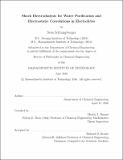| dc.contributor.advisor | Martin Z. Bazant. | en_US |
| dc.contributor.author | Schlumpberger, Sven | en_US |
| dc.contributor.other | Massachusetts Institute of Technology. Department of Chemical Engineering. | en_US |
| dc.date.accessioned | 2018-02-16T19:27:39Z | |
| dc.date.available | 2018-02-16T19:27:39Z | |
| dc.date.copyright | 2016 | en_US |
| dc.date.issued | 2016 | en_US |
| dc.identifier.uri | http://hdl.handle.net/1721.1/113735 | |
| dc.description | Thesis: Ph. D., Massachusetts Institute of Technology, Department of Chemical Engineering, 2016. | en_US |
| dc.description | This electronic version was submitted by the student author. The certified thesis is available in the Institute Archives and Special Collections. | en_US |
| dc.description | Cataloged from student-submitted PDF version of thesis. | en_US |
| dc.description | Includes bibliographical references (pages 153-162). | en_US |
| dc.description.abstract | Desalination systems have become an important part of many water supply networks, and they have also been considered as solutions for water shortages and in areas in which access to clean and safe water is still a problem. The quality of available water that is encountered in these situations tends to vary significantly, ranging from seawater to just slightly brackish water to even just water with trace amounts of toxic ions or small amounts of infectious bacteria or viral particles. While current technologies provide a very good solution to desalinating seawater via reverse osmosis, the solutions that are currently used for brackish water or contaminated water are often suboptimal in that they often operate inefficiently in this regime. It is also often difficult to deploy these systems in environments with little infrastructure. In this thesis, shock electrodialysis is proposed and examined for its potential to effectively provide a solution for use with brackish and contaminated water. Shock electrodialysis is in many ways related to electrodialysis, but it is based on the emerging science of desalination shocks in porous media, giving it the distinct advantage of using fewer membranes and separating fresh and brine stream via a non-physical internal barrier (i.e. the shock), which then also allows for removal of particles. Furthermore, in contrast to electrodialysis, it is able to completely deionize water, which is extremely important when dealing with water sources that are contaminated with traces of toxic ions. Experimental results from a proof-of-concept prototype are presented and compared with numerical and analytical modeling results with the aim to better understand the important factors in shock electrodialysis. These results suggest that, while shock electrodialysis can indeed fully deionize water, the energy efficiency is still very poor and needs to be significantly improved before this technology can be effectively employed in the field. In addition to shock electrodialysis, this thesis also explores the use of a 4th-order Poisson equation to include ion-ion correlations in a simple manner when modeling two different electrolyte systems. The first system considered is a surface that was coated with a polyelectrolyte in solution with a simple electrolyte of varying concentration. This system is of interest, because, as the concentration changes, inversion of the apparent difference in potential between this surface and a surface that is not coated with polyelectrolyte is found to occur, a phenomenon that is not explained by traditional models. The second system considered is simply a bulk electrolyte solution in which the aim was to improve the Debye- Hückel theory for ionic activity to be able to more accurately predict the activity using a very simple model. In both systems, correlations proved to be important to varying degrees and the 4th-order equation proved to be useful in better predicting the observed phenomena. | en_US |
| dc.description.statementofresponsibility | by Sven Schlumpberger. | en_US |
| dc.format.extent | 162 pages | en_US |
| dc.language.iso | eng | en_US |
| dc.publisher | Massachusetts Institute of Technology | en_US |
| dc.rights | MIT theses are protected by copyright. They may be viewed, downloaded, or printed from this source but further reproduction or distribution in any format is prohibited without written permission. | en_US |
| dc.rights.uri | http://dspace.mit.edu/handle/1721.1/7582 | en_US |
| dc.subject | Chemical Engineering. | en_US |
| dc.title | Shock electrodialysis for water purification and electrostatic correlations in electrolytes | en_US |
| dc.type | Thesis | en_US |
| dc.description.degree | Ph. D. | en_US |
| dc.contributor.department | Massachusetts Institute of Technology. Department of Chemical Engineering | |
| dc.identifier.oclc | 1022948766 | en_US |
